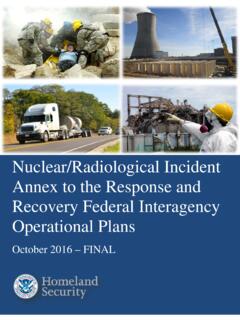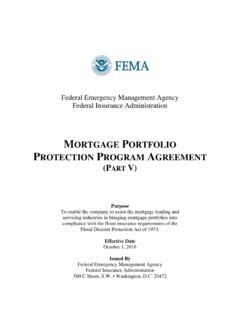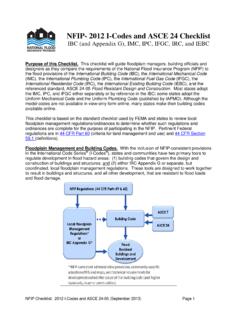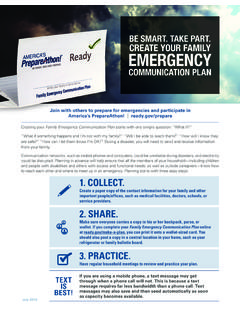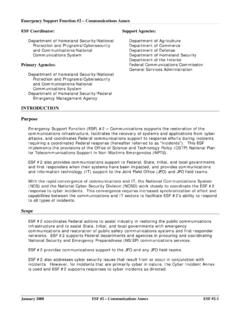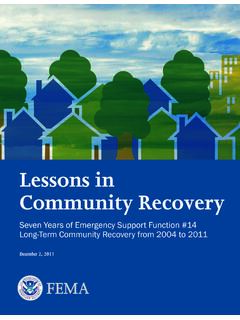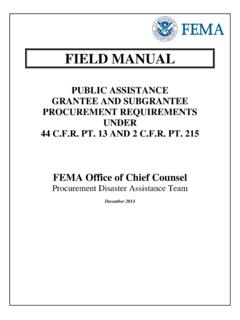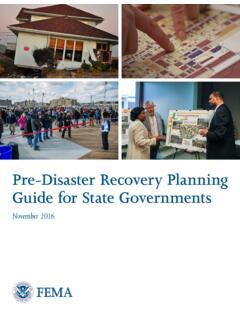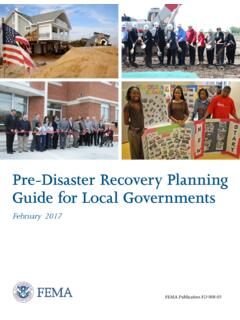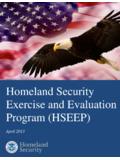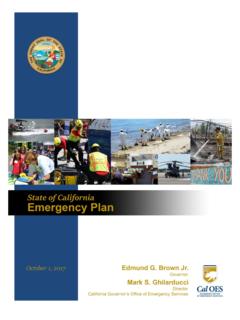Transcription of PUBLIC ASSISTANCE: REASONABLE COST EVALUATION
1 Job Aid PUBLIC ASSISTANCE: REASONABLE cost EVALUATION . The federal emergency management agency (FEMA) PUBLIC Assistance (PA) Program provides supplemental assistance to States, Territories, Tribes, and local governmental entities, as well as certain private nonprofit (PNP) organizations (hereinafter referred to as Applicants). FEMA's PUBLIC Assistance Program and Policy Guide ( ) provides comprehensive information regarding assistance that FEMA can provide and the requirements that Applicants must follow in order to receive the assistance. This Job Aid supersedes FEMA's PUBLIC Assistance Alternative Procedures Pilot Program Validation of Subgrantee-Provided cost Estimates Job Aid, dated May 20, 2013. It provides uniform guidance to FEMA personnel on evaluating cost reasonableness for federal funds expended by non- federal entities, also referred to as Applicants in this guidance, under the PA Program in accordance with Title 2 Code of federal Regulations (CFR) . , and for disasters declared prior to December 26, 2014, in accordance with 44 CFR part 13 and the Office of management and Budget (OMB) Circular A-87.
2 This Job Aid includes a checklist in Appendix A: Validation of Applicant-Provided cost Estimates, which FEMA staff must use to review and validate cost estimates submitted to FEMA for Permanent Work. Applicability This guidance applies to any assessment of cost reasonableness undertaken by FEMA for relevant work completed under a PA grant award or subaward. It provides general information to guide FEMA. personnel in evaluating whether costs are REASONABLE including when necessary as the result of a financial review such as closeout or administrative appeals, Department of Homeland Security Office of the Inspector General (DHS OIG) audits, single audits under 2 CFR part 200, and Improper Payments Elimination and Recovery Act audits. cost eligibility is a basic component of PA Program eligibility, and in order for a cost to be considered allowable, it must be necessary and REASONABLE to accomplish the work properly and FEMA. evaluates cost reasonableness for all projects.
3 In addition, the determination of cost reasonableness is also instructive with regard to grant non-compliance enforcement remedies. Generally, FEMA considers an Applicant's force account labor, equipment, and materials costs as REASONABLE provided the costs are consistent with the entity's policies including, but not limited to, pay rates, labor policies, and cost schedules utilized during its normal operations. Contract costs are generally considered REASONABLE when the Applicant adheres to full and open competition under applicable federal procurement under grant requirements, and the scope of services or work in the contract and level of effort is consistent with respect to the eligible scope of work. For these situations, FEMA staff are not required to perform a detailed cost reasonableness analysis. 1. 2 CFR FEMA's mission is helping people before, during, and after disasters.. October 13, 2018. federal emergency management agency REASONABLE Costs General Information Definition2.
4 A cost is REASONABLE if, in its nature and amount, it does not exceed that which would be incurred by a prudent person under the circumstances prevailing at the time the decision was made to incur the cost . Factors to Consider in Determining REASONABLE Costs3. FEMA considers many factors in evaluating whether costs are REASONABLE , including: Factor Example Whether the cost is of a type generally recognized as The appropriate skill level and/or level of effort to ordinary and necessary for the operation of the complete the required activity Applicant or the proper and efficient performance of the federal award The restraints or requirements imposed by such factors Whether the Applicant participated in ethical business as: sound business practices; arm's length bargaining; practices, ensuring parties to a transaction are federal , Tribal, State, local, and other laws and independent of each other, without familiar ties or regulations; and terms and conditions of the federal shared interests and on equal footing without one party award having control of the other Market prices for comparable goods or services for the When escalated costs are due to shortages, FEMA.
5 Geographic area, particularly in the context of post- considers whether the Applicant's work continued disaster conditions, which may cause shortages of beyond the period of shortages and whether there was skilled labor, building materials, and energy sources an opportunity for the Recipient/Subrecipient to obtain more REASONABLE pricing Whether the individuals concerned acted with Were there emergency or exigent circumstances? prudence in the circumstances considering their responsibilities to the Applicant, its employees, its students or membership, the PUBLIC at large, and the federal Government Whether the Applicant significantly deviates from its Did the Applicant comply with procurement established practices and policies regarding the requirements? incurrence of costs, which may unjustifiably increase the federal award's cost FEMA also considers project-specific complexities that may affect costs, such as: environmental or historic issues; remote access or location; provision of a unique service with few providers; and elements requiring an extraordinary level of effort.
6 2. 2 CFR ; OMB Circular A-87. 3. Id. FEMA's mission is helping people before, during, and after disasters.. Page 2 of 9 October 13, 2018. federal emergency management agency Process to Determine REASONABLE Costs In conducting a REASONABLE cost analysis, FEMA will perform a preliminary review of the documentation to assess the complexity of the project and expertise required to complete the analysis. If specialized expertise is required, FEMA will utilize a subject matter expert with the appropriate specialized skills, knowledge, experience, or capability in the appropriate field such as engineering, architecture, or cost estimating. FEMA, in consultation with the subject matter experts as necessary, will then determine the appropriate methodology or methodologies to assess REASONABLE costs. This assessment will be based on several factors, such as the circumstances surrounding the event, availability of materials, project type, complexity, sole sourcing, best construction practices, codes and standards, and other relevant information available at the time of EVALUATION .
7 This may require requesting additional information from the Applicant. If the Applicant does not provide supporting documentation, FEMA will inform the Applicant of the determination to deobligate funding or to deny obligation of funding, as applicable, and the Applicant may appeal the determination and provide necessary information at that time. If the costs determined REASONABLE are lower than actual costs for the subaward, FEMA's Office of Chief Counsel (OCC) may also review the findings, where warranted. An example of where engagement with OCC may be necessary is determining if an Applicant's contract EVALUATION (resulting in award to higher bidder) was performed correctly. While PA costing specialists have the qualifications to determine REASONABLE costs, OCC has contracting and procurement qualifications and PA should engage OCC in such an EVALUATION whenever uncertain contract award selection questions arise. FEMA will record the results of the REASONABLE cost analysis in the appropriate award file or Grants management System.
8 Methodology to Determine REASONABLE Costs The method(s) used to evaluate costs will depend on the type of project and the resources and information available. The first step in any EVALUATION of REASONABLE costs is to verify that all items of work included in the cost are eligible. If an item is not eligible based on the approved scope of work, FEMA will remove the associated cost from the estimate. FEMA will then notify the Recipient and Subrecipient accordingly if ineligible items have been removed. FEMA then evaluates whether costs for the approved scope of work are comparable to relevant current market prices for similar goods or services using the best information available for the project, which may include any of the following resources. 1. Validation of Recipient or Subrecipient's cost or Price Analysis Per 2 CFR (a), non-State Applicants must perform a cost or price analysis in connection with every procurement action in excess of the Simplified Acquisition Threshold, including contract modifications.
9 The method and degree of analysis depends on the facts surrounding the particular procurement situation, but as a starting point, the non-State Applicant must make independent estimates before receiving bids or proposals. While State entities are not required by 2 CFR (a) to conduct a cost or price analysis, it is advisable that they do so in completing their procurements. FEMA's mission is helping people before, during, and after disasters.. Page 3 of 9 October 13, 2018. federal emergency management agency When an Applicant provides a cost or price analysis, FEMA will review the analysis as part of its EVALUATION of REASONABLE costs. For example, this may be useful in evaluating reasonableness when price competition is lacking or when the selection was non-compliant with the applicable procurement under grant requirements even though there may have been price competition. If the Applicant does not submit a cost or price analysis (because not required to do one in the case of State entities, or because it did not do one as required in the case of non-State entities) and price competition was lacking or its selection was non-compliant with the applicable procurement under grant requirements, then FEMA should identify the elements that would otherwise have been a part of a cost or price analysis (for more information, see the detailed resources available from FEMA's Procurement Disaster Assistance Team here: ).
10 FEMA. may request that the Applicant provide this information in order to evaluate REASONABLE costs. The cost or price analysis is one component of documentation that an Applicant may use to support that its costs are REASONABLE . FEMA may use the methodologies described below to evaluate costs both in conjunction with, and in the absence of, this information, as appropriate. 2. Historical Costs and Average Weighted Unit Prices FEMA may compare the Applicant's costs to the Applicant's historical costs for a similar scope of work or items. Where an Applicant procures the same or similar supplies or services over a period of time, an Applicant may be able to provide documentation of historical costs to demonstrate comparable costs, adjusted for inflation or other factors as necessary. Other factors may include, but are not limited to, changes in codes and standards, availability of in-kind construction material, quantity, delivery schedules, and the economy. This may not be a flat inflation rate, because some types of work may have a different inflation rate than others.
